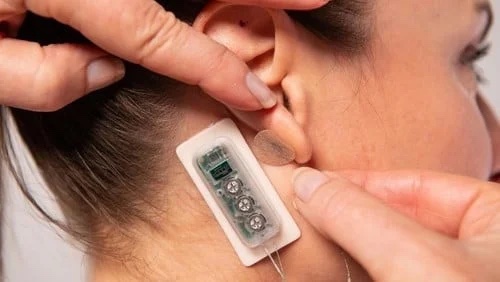Treating Diabetic Nerve Damage Without Surgery or Implants
By Andrew Briskin
 Spinal cord stimulators, a type of implantable device, have been researched as a treatment for painful diabetic neuropathy, a complication of diabetes that leads to painful nerve damage in the extremities. A new device recently cleared by the FDA can reduce nerve pain without the need for surgery.
Spinal cord stimulators, a type of implantable device, have been researched as a treatment for painful diabetic neuropathy, a complication of diabetes that leads to painful nerve damage in the extremities. A new device recently cleared by the FDA can reduce nerve pain without the need for surgery.
Diabetic neuropathy is a serious complication of diabetes that occurs when high glucose levels damage the nerves in the extremities, such as the hands, legs, and feet. This can lead to varying levels of pain; depending on the individual, this can range from a mild tingling or numbness to severe, stabbing pains.
Previously, treatments were limited to pain medications, which sometimes had unpleasant side effects. However, a new technology called a spinal cord stimulator, or neurostimulator, offers another treatment option with fewer side effects and longer-lasting relief than pain medications. The FDA has cleared several neurostimulator devices in recent years, including devices manufactured by Medtronic and Nevro.
Neurostimulators generate small electrical impulses, which can block the body’s pain signals from reaching the brain. While the devices do not treat the underlying cause of neuropathy, they have led to significant and long-lasting pain relief for many with the condition.
Up until now, spinal cord stimulators had to be implanted under the skin, which required a visit to the clinic for an out-patient surgical procedure. A new device developed by the biotechnology company DyAnsys, known as First Relief, offers a less invasive approach.
First Relief was cleared by the FDA in July 2022 as a treatment for pain caused by diabetes-related nerve damage. Unlike other spinal cord stimulators, this “neurostimulator” sits on the skin just behind the ear and does not require surgical implantation. The device features three small, acupuncture-like needles that reach just under the skin, which put out small electrical impulses over several days. The FDA has cleared the device for several multi-day treatments for up to eight weeks.
In a recent clinical trial of First Relief, 63 participants with diabetes-related nerve pain reported significant reductions in pain. This pain reduction lasted through the 90-day follow-up after the trial, demonstrating that the device could have long-lasting effects on pain relief. The participants also reported improvements in sleep and overall mood.
Spinal cord stimulators offer the opportunity for significant pain relief and improvements to quality of life for people living with diabetes-related nerve pain, without many of the unwanted side effects from medications. With First Relief, people now have an additional option that does not require surgery.
To learn more about neuropathy or spinal cord stimulation technology, check out these resources:








